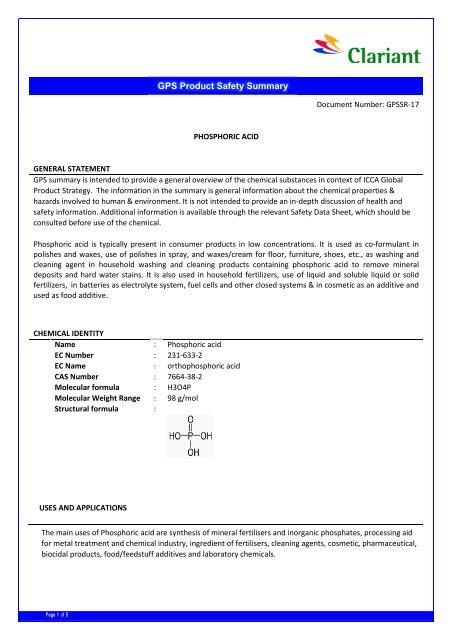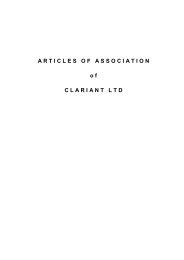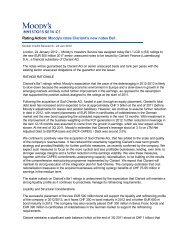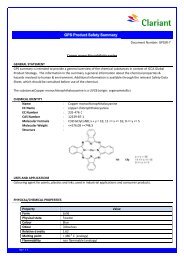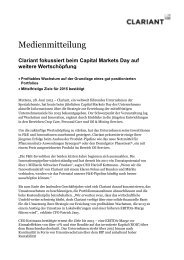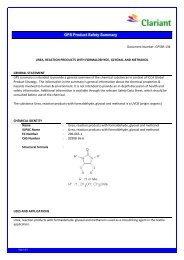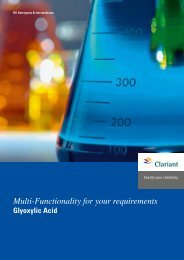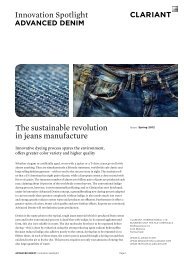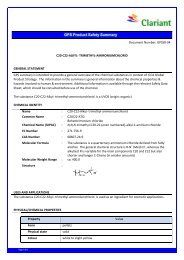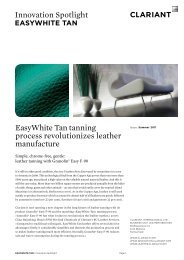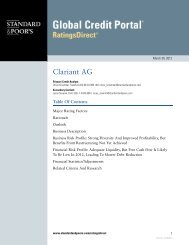GPS Summary Report 17 Phosphoric acid Final - Clariant
GPS Summary Report 17 Phosphoric acid Final - Clariant
GPS Summary Report 17 Phosphoric acid Final - Clariant
You also want an ePaper? Increase the reach of your titles
YUMPU automatically turns print PDFs into web optimized ePapers that Google loves.
<strong>GPS</strong> Product Safety <strong>Summary</strong><br />
Document Number: <strong>GPS</strong>SR-<strong>17</strong><br />
PHOSPHORIC ACID<br />
GENERAL STATEMENT<br />
<strong>GPS</strong> summary is intended to provide a general overview of the chemical substances in context of ICCA Global<br />
Product Strategy. The information in the summary is general information about the chemical properties &<br />
hazards involved to human & environment. It is not intended to provide an in-depth discussion of health and<br />
safety information. Additional information is available through the relevant Safety Data Sheet, which should be<br />
consulted before use of the chemical.<br />
<strong>Phosphoric</strong> <strong>acid</strong> is typically present in consumer products in low concentrations. It is used as co-formulant in<br />
polishes and waxes, use of polishes in spray, and waxes/cream for floor, furniture, shoes, etc., as washing and<br />
cleaning agent in household washing and cleaning products containing phosphoric <strong>acid</strong> to remove mineral<br />
deposits and hard water stains. It is also used in household fertilizers, use of liquid and soluble liquid or solid<br />
fertilizers, in batteries as electrolyte system, fuel cells and other closed systems & in cosmetic as an additive and<br />
used as food additive.<br />
CHEMICAL IDENTITY<br />
Name : <strong>Phosphoric</strong> <strong>acid</strong><br />
EC Number : 231-633-2<br />
EC Name : orthophosphoric <strong>acid</strong><br />
CAS Number : 7664-38-2<br />
Molecular formula : H3O4P<br />
Molecular Weight Range : 98 g/mol<br />
Structural formula :<br />
USES AND APPLICATIONS<br />
The main uses of <strong>Phosphoric</strong> <strong>acid</strong> are synthesis of mineral fertilisers and inorganic phosphates, processing aid<br />
for metal treatment and chemical industry, ingredient of fertilisers, cleaning agents, cosmetic, pharmaceutical,<br />
biocidal products, food/feedstuff additives and laboratory chemicals.<br />
Page 1 of 5
<strong>GPS</strong> Product Safety <strong>Summary</strong><br />
PHYSICAL/CHEMICAL PROPERTIES<br />
Property<br />
Physical state (at 20 °C &<br />
1013 hPa)<br />
Colour<br />
Solid / Liquid<br />
clear colorless/transparent solid,<br />
colourless viscous liquid<br />
Value<br />
Relative Density 1.840 at 38 °C<br />
Melting / freezing point 41.1 °C at 1013 hPa<br />
Boiling point<br />
296.5 °C at 1013 hPa<br />
Water solubility 1000 g/L at 20°C<br />
Vapour pressure 4 Pa at 20 °C<br />
Oxidizing properties Oxidising properties not to be expected (structure)<br />
Explosive Properties Explosive properties not to be expected (structure)<br />
Flammability<br />
Flammability not to be expected (structure)<br />
Dissociation constant pKa1 = 2.1, pKa2 = 7.2, pKa3 = 12.3 at 20 deg C<br />
Viscosity<br />
1.1 cP (mPa.s) at 5% <strong>Phosphoric</strong> Acid to 600 cP (mPa.s) at 105% <strong>Phosphoric</strong><br />
Acid, at 20°C.<br />
HEALTH EFFECTS<br />
Human Health Safety Assessment<br />
<strong>Phosphoric</strong> <strong>acid</strong> causes severe skin burns and eye damage<br />
Consumer : consumer products containing phosphoric <strong>acid</strong> are polishes and waxes, washing and cleaning<br />
products, fertilizers and soldering aids. Safety advices are provided by resistant labelling-package labels and,<br />
depending on the phosphoric <strong>acid</strong> concentration in the mixture, child-resistant fastening and tactile warning of<br />
danger. <strong>Phosphoric</strong> <strong>acid</strong> is not provided as such to consumers and general public.<br />
Worker : <strong>Phosphoric</strong> <strong>acid</strong> is manufactured by a controlled process in order to avoid irritating mists, sprayings and<br />
potential splashes. In addition general ventilation/local exhaust ventilation and personal protective equipment<br />
have to be applied. Hence little potential exists for exposure of workers. In case of unintended exposure during<br />
maintenance, sampling, testing, or other procedures, workers should follow the recommended safety and firstaid<br />
measures in the Safety Data Sheet.<br />
Effect Assessment<br />
Acute Toxicity<br />
Oral/Inhalation/Dermal<br />
Irritant effect on skin &<br />
eyes<br />
Sensitisation<br />
Genotoxicity /<br />
Mutagenicity<br />
Results<br />
No acute oral toxicity<br />
No dermal and inhalation toxicity to be expected<br />
Corrosive to skin<br />
Causes serious eye damage<br />
Corrosive to skin and therefore not tested<br />
Not mutagenic in genetic toxicity in-vitro<br />
Page 2 of 5
<strong>GPS</strong> Product Safety <strong>Summary</strong><br />
ENVIRONMENTAL EFFECTS<br />
Environment Safety Assessment<br />
Low pH caused by adding phosphoric <strong>acid</strong> can result in toxic effects of aquatic organisms.<br />
No environmental classification is proposed since no (adverse) effects have been observed in the ecotoxicological<br />
testing in pH neutral test solutions (see below).<br />
Effect Assessment<br />
Results<br />
Acute Fish toxicity No toxicity to be expected at pH 6 - 9<br />
Acute Daphnia toxicity Not toxic with pH adjusted to neutral<br />
Algae toxicity<br />
Not toxic with pH adjusted to neutral<br />
Fate and Behaviour<br />
Biodegradation<br />
Bioaccumulation<br />
potential<br />
PBT / vPvB conclusion<br />
Results<br />
Not applicable to inorganic substances<br />
No bioaccumulation potential<br />
Criteria for identification of PBT- and vPvB substances not applicable to<br />
inorganic substances<br />
EXPOSURE<br />
Human Health : Exposure to <strong>Phosphoric</strong> <strong>acid</strong> of personnel in manufacturing facilities is considered low because<br />
the process, storage and handling operations are under industrial hygiene considerations and occupational safety<br />
measures for dangerous substances . Workers who might accidentally come in contact with the substance should<br />
follow the safety and first-aid measures recommended in the Safety Data Sheet.<br />
Phosphorous compounds are an important component of living matter and all organisms contain a certain<br />
quantity. <strong>Phosphoric</strong> <strong>acid</strong> can be readily utilized by aquatic/terrestrial plants and microorganisms. Due to its high<br />
water solubility and low vapour pressure phosphoric <strong>acid</strong> is mainly found in soil and water compartments. A pH<br />
range of 6-9 is generally considered safe for aquatic organisms.<br />
RISK MANAGEMENT RECOMMENDATIONS<br />
• Consumer : <strong>Phosphoric</strong> <strong>acid</strong> is corrosive to skin and causes severe eye damage. It is not provided as such to<br />
consumers and general public. It is used in formulations which are available to general public as various<br />
cleaning products, including polishes and waxes, some household fertilizers (garden products). In general<br />
terms the concentration of phosphoric <strong>acid</strong> in these products are low and rarely exceed 10 %. For products<br />
containing phosphoric <strong>acid</strong> at concentration > 10%, keep them out of reach of children, keep away from eyes,<br />
Page 3 of 5
<strong>GPS</strong> Product Safety <strong>Summary</strong><br />
use proper PPEs, if product gets into eyes rinse thoroughly with water, rinse and dry hands after use, do not<br />
ingest, if the product is ingested then seek medical advice, do not change container to store contents, do not<br />
mix with other products, do not apply product into ventilator openings or slots & ventilate the room after<br />
use.<br />
STATE AGENCY REVIEW<br />
This substance has been registered under REACH.<br />
REGULATORY INFORMATION / CLASSIFICATION AND LABELLING<br />
Labeling according CLP regulation (Regulation (EC) No. 1272/2008, as amended) for concentrations ≥ 25 %:<br />
Signal word: Danger<br />
Hazard pictogram:<br />
GHS05: corrosion<br />
Hazard statements:<br />
H314: Causes severe skin burns and eye damage.<br />
Precautionary statements:<br />
P280 Wear protective gloves/protective clothing/eye protection/face<br />
protection.<br />
P301 + P330 + P331 IF SWALLOWED: Rinse mouth. Do NOT induce vomiting.<br />
P303 + P361 + P353 IF ON SKIN (or hair): Remove/Take off immediately all<br />
contaminated clothing. Rinse skin with water/shower.<br />
P305 + P351 + P338 IF IN EYES: Rinse cautiously with water for several minutes.<br />
Remove contact lenses, if present and easy to do. Continue<br />
rinsing.<br />
P308 IF exposed or concerned:<br />
P310 Immediately call a POISON CENTER or doctor/physician.<br />
CONCLUSION<br />
Page 4 of 5
<strong>GPS</strong> Product Safety <strong>Summary</strong><br />
CONTACT INFORMATION WITHIN COMPANY<br />
<strong>Clariant</strong> Produkte (Deutschland) GmbH<br />
65926 Frankfurt am Main<br />
Telephone no. : +49 69 305 18000<br />
GLOSSARY<br />
Acute toxicity: harmful effects after a single exposure<br />
Biodegradable: breakdown of materials by a physiological environment<br />
Bioaccumulation : accumulation of substances in the environment<br />
Carcinogenicity: effects causing cancer<br />
Chronic toxicity: harmful effects after repeated exposures<br />
Clastogen: a substance that causes breaks in chromosomes<br />
Embryotoxicity: harmful effects on foetal health<br />
GHS: Global Harmonized System<br />
Hazard: situation bearing a threat to health and environment<br />
Mutagenicity: effects that change genes<br />
Reprotoxicity: combining teratogenicity, embryotoxicity and harmful effects on fertility<br />
Sensitising: allergenic<br />
Teratogenic: effects on foetal morphology<br />
DATE OF ISSUE<br />
January 2012<br />
REVISION<br />
ADDITIONAL INFORMATION<br />
DISCLAIMER<br />
The information contained in this paper is intended as advice only and whilst the information is provided in<br />
utmost good faith and has been based on the best information currently available, is to be relied upon at the<br />
user’s own risk.<br />
No representations or warranties are made with regards to its completeness or accuracy and no liability will be<br />
accepted by <strong>Clariant</strong> for damages of any nature whatsoever resulting from the use of or reliance on the<br />
information.<br />
Page 5 of 5


